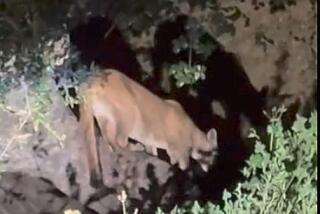Review: Big Cat Week on National Geographic Wild spots a leopard
For the premiere episode of its third annual Big Cat Week, National Geographic Wild has upped the stakes.
Having already explored man-eating lions and most of their lethally gorgeous kindred, this Big Cat Week opens Sunday night in Kabul where big cat tracker and National Geo fave Boone Smith and his team stops before entering the mountains in search of the elusive snow leopard.
Hoping to find a part for their busted radio transmitter, they wander the streets of the Afghanistan capital like “Homeland” extras, while the requisite urgent voiceover explains that the Taliban is currently on a killing spree and that Smith and his team would do well to keep a low profile.
PHOTOS: Celebrities by The Times
Rather difficult to do for the movie-star handsome Smith (seriously, are big cat trackers drawn from the same gene pool as paramedics and firefighters?) and, of course, his camera crew. But no matter, the colorful marketplace gives the piece the regional flavor on which National Geographic has built its reputation and if the anxiety-provoking soundtrack does force one to wonder if Mandy Patinkin’s Saul will be appearing from a shadowy doorway with the necessary hardware, no doubt a visit to Afghanistan contains a certain amount of danger even for environmentalists. (Memo to CIA: When next you have to rescue hostages from a foreign city à la “Argo,” send in the National Geo big cat team.)
Joining Smith in the field is John Goodrich, another good-looking if a bit more laid-back conservation scientist as well as local tracker Hussain Ali who, mercifully, looks like a normal person. Up we go into the mountains, learning how global warming is decreasing the snow pack that, though a boon to native herders, is decreasing the leopard’s natural habitat.
This sort of information is the stated raison d’etre for Big Cat Week, which is part of the Big Cats Initiative’s attempt to increase awareness about dwindling and endangered species. Snow leopards, found only in the mountains of Central Asia where they are hunted by herders and poachers seeking their fur and spectacular tails, are on the endangered list. (Interesting fact: They cannot roar.) And indeed, while in Kabul, Smith finds it easier to procure an illegal snow leopard pelt than a radio part.
Up we go into the mountains, where we learn about the tracking patterns of the leopards and watch the experts train local conservationists on how to set a snare and use a tranquilizer gun. The team hopes to put tracking collars on several leopards to learn more about the population.
It is laborious and often boring work. An intrusive voice tries too hard to keep the mood tense by asking things like “will the team get the traps set in time?,” which is pretty annoying since it is safe to assume that they will.
THE ENVELOPE: Awards season has arrived
And indeed, they do, leading to 10 or 15 truly exciting minutes in which we see both the un-scripted excitement of the team (the local conservationist is so excited, Smith has to calm him down so he doesn’t upset the leopard) and the exquisite leopard himself. During those dead-of-night moments, the tension is quite real.
Watching the animal struggle while the guys with the tranqs hurry up the trail and take aim, the viewer joins the team in admiring the beauty of the leopard and fearing for its well-being, both before it is sedated and after, when the drug leaves the animal groggy and in real danger of slipping from its steep and unstable mountainside.
It’s a lot of work for a few moments of splendor, but that’s how it goes when you’re hunting the big cats.
--
‘Snow Leopard of Afghanistan’
Where: National Geographic Wild
When: 8 p.m. Sunday
Rating: TV-14-L (may be unsuitable for children under the age of 14 with an advisory for coarse language)
PHOTOS, VIDEOS & MORE:
PHOTOS: Holiday TV specials
PHOTOS: 15 shocking moments from ‘South Park’
VIDEO: Watch the latest fall TV trailers here
More to Read
The complete guide to home viewing
Get Screen Gab for everything about the TV shows and streaming movies everyone’s talking about.
You may occasionally receive promotional content from the Los Angeles Times.







